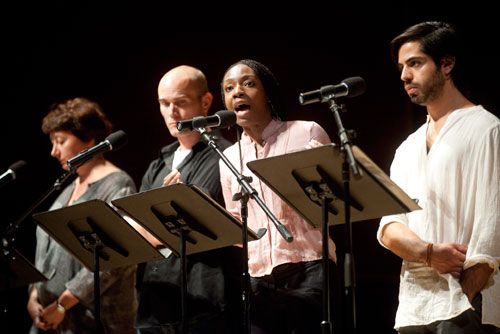
A “Moment of Interfaith Prayer and Reflection” was held on the steps of the Memorial Church in Harvard Yard at 8:46 a.m., the exact time that American Flight 11 crashed into the north tower of the World Trade Center.
Rose Lincoln/Harvard Staff Photographer
Mourning 10, and 3,000
Harvard remembers 9/11, when everything changed
Recalling victims and heroes alike
On the day of the 9/11 terror attacks, Harvard lost 10 members of its alumni family. Included were three graduates of Harvard College and three from Harvard Business School.
On the 10th anniversary of the attacks, Harvard students, faculty, and staff joined in remembering that tragic day and the darkness it brought — and the light it may someday bring. They created an eclectic set of events and installations to remember these Harvard graduates and the other victims of terror and the heroes responding to it worldwide in the past decade.
In doing so, Harvard added its own grace notes to many 9/11 remembrances spanning the globe. At the start of the day was an early-morning memorial run; at the end of the day were candlelight vigils that lit up the dark. In between came music, dance, and centering discussion.
Artifacts of the 9/11 remembrance at Harvard remain: a series of outdoor poem pillars dedicated to the Harvard dead. “Violence has changed me,” reads one in part, an excerpt from Louise Glück’s “October.” But then later, “Tell me this is the future,” she writes. “I won’t believe you.”

A morning run in tribute
On most Sundays at 6:30 in the morning not much is happening on Cambridge Common, the public green across Massachusetts Avenue from Harvard Yard. This Sunday was no different, until Maj. Stephen Flanagan, M.Ed. ’11, parked his car on a side street and unloaded two cartons of T-shirts and an American flag. As if by magic, crowds of fit runners within minutes appeared from every direction and gathered near Flanagan just off Garden Street. It was the very spot where in 1775 George Washington had assembled the first Continental Army.
Flanagan, a mid-career Army officer and now an M.P.A. student at the Harvard Kennedy School (HKS), had helped to organize a 9/11 Memorial Run to the Boston Common, one of many runs sponsored nationwide — and in Afghanistan — by Team Red, White & Blue, a nonprofit coalition of athletes, veterans, and athletes that helps to reintegrate wounded veterans into society.
The run is a tribute to the fallen from the 9/11 attacks, said Flanagan, and “for the heroes who have died fighting since.” Co-organizing the run was Capt. Charles Lewis, also a mid-career student at HKS, where he is president of the 70-member Armed Forces Committee, a veterans’ club. He did two tours in Iraq as an artillery officer. Tall and strong, Lewis looks like he could jog to Boston with a howitzer on his back.
For Flanagan, lithe and fit, the five-mile run ahead was hardly the toughest thing he has ever done. During 10 years and two months in the service, he was deployed with the Army Special Forces three times in Iraq and once in Afghanistan. On the day of the 9/11 attacks, he heard his commanding officer say, “You’re going to war because of this.”
By 7 a.m., 150 runners had donned red event T-shirts and assembled around Flanagan. He praised the heroes and victims of the 9/11 attacks and the wars that came after, finishing with, “Let us now carry Old Glory over to Boston.” He unfurled the flag and started jogging. He held the flag upright and flying. Behind him a column of runners flowed like an undulant red wave through Harvard Square.
A ‘way out of this dark wood’
Ten years ago, nearly 5,000 people gathered on the steps of the Memorial Church in an impromptu outpouring of grief, healing, and spiritual togetherness.
For anyone who questioned whether in modern times “Harvard should continue to have this church at the center of this yard,” the gathering “sent a resounding affirmation,” said David Gergen, the Public Service Professor of Public Leadership at Harvard Kennedy School and director of the Center for Public Leadership, who gave today’s 11 a.m. sermon.
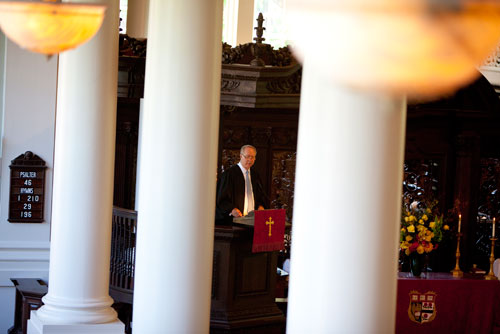
The crowd at the church this Sept. 11 was considerably smaller than on that day, but the anniversary still inspired deep introspection.
The absence of the late Rev. Peter J. Gomes, the church’s Pusey Minister who died in February from complications of a stroke, loomed over the service. In his talk, Gergen explored Gomes’ central messages in the wake of 9/11: not to assume God offers special protection to the United States; not to fear that God will disappear in tough times; to know that inner strength in adversity comes through walking with God and sustaining “lives of compassion.”
The terror attacks ushered in “an extremely difficult and disappointing decade for this country,” Gergen told the congregation. The intervening years have been marked by war, natural disasters, political fracturing, and moral uncertainty about the nation’s response to crisis.
“The nature of the threat we face has changed, so that what is required of us as a people of faith has changed too,” he continued. “Then, we were frightened by what bad people were doing to us. Today, the larger threat comes from what we are allowing to happen to each other.”
The suffering wrought by the financial crisis that began in 2008 is as devastating as the effects of 9/11, but in a different way, he continued.
“We dare not live in a society in which a small number of us live in sunshine, but a great multitude are stuck in a dark wood,” Gergen said, as the late-morning sun shone behind him through the windows of Appleton Chapel. “We must find our way out of this dark wood, but the debate rages on.”

Four times, the bells echo losses
Tragedies that ripple worldwide and change history are remembered with horrible exactitude. So it was with the 9/11 attacks. Terrorists deployed four jetliners as weapons, three of them successfully. Each impact is engraved in time: 8:46 a.m., 9:03 a.m., 9:40 a.m., and 10:03 a.m.
On the 10th anniversary of the attacks, these exact times were marked by the tolling bells at the Memorial Church at Harvard and at Lowell House. The first bells chimed in counterpoint, 10 years to the moment when a hijacked Boeing 767 slammed into the north tower of the World Trade Center.
Outside the Memorial Church, the tolling had other counterpoints: the off-key chatter of birds in the treetops, and the sounds of an infant, oblivious to any ceremony. There was a mild breeze, and the sun filtered through the tree canopy. Among the 90 observers standing silently, at least some had to be thinking: We survived. The Earth — with its birds and sunlight and babies — will abide.
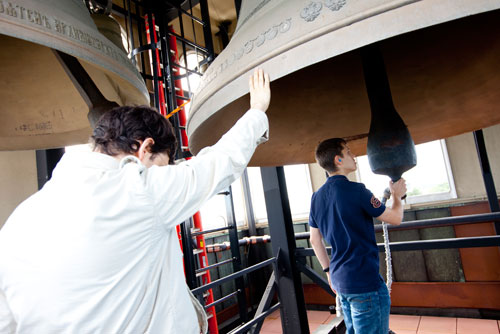
Before and after the tolling, the silence of Tercentenary Theatre was solemn and deep. “Peace be with you,” said the Rev. Robert J. Mark, breaking the silence. The Presbyterian minister, a McDonald Fellow at the Memorial Church, guided a brief ceremony. Rabannit Sharon Weiss-Greenberg, a Harvard chaplain, read a prayer in Hebrew. Zoroastrian chaplain Daryush Mehta filled the silence with “Méditation,” adapted for solo clarinet from the opera “Thaïs.” Afterward, he said he had learned the piece for a wedding.
Mohammed Sheehan Rahman ’14, an Adams House sophomore who grew up in Manhattan, sang an Islamic devotional in Urdu. It was tremulous and haunting, like a Muslim call to prayer. It was also resonant of tragedy and renewal, and spoke for all faiths. “I am bowing at your feet, have fallen, and recovered,” the song goes in part. “Improve my fortune, my destiny, oh Lord.”
At the end, Mark prayed, “Let us together paint the portrait of a global family.”
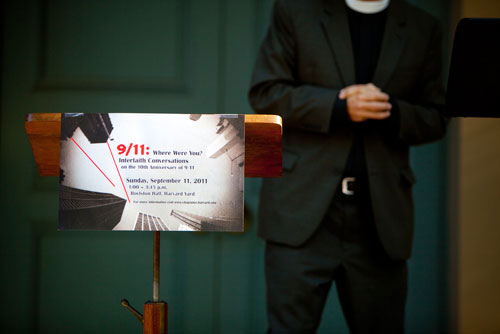
After a decade, ‘Life steps almost straight’
There’s no knowing what 19th-century poet Emily Dickinson would have made of the terror attacks of Sept. 11, 2001, but she did know tragedy and how to cope with it. In “We Grow Accustomed to the Dark” (circa 1862), she wrote of those times in life “When light is put away.”
In the end, though:
Either the Darkness alters —
Or something in the sight
Adjusts itself to Midnight —
And Life steps almost straight.
Ten years after the attacks, life for most Americans “steps almost straight.” Meanwhile, poetry can help. After all, as Dickinson writes in the same poem, when darkness falls even “The Bravest — grope a little.”

Such succoring poems are painted on pale green steel pillars that are now fixtures on the Cambridge campus. Each pillar has a poem or part of one on it. Painted around the top of each pillar are the names of the 10 Harvard alumni who lost their lives in the attacks.
Dickinson offers her unwitting wisdom on a pillar in front of Widener Library. Closer to Emerson Hall, Louise Glück has a fragment from “October,” a poem more explicitly about 9/11 and the sense of loss it brought. It begins, “Summer after summer has ended.”
For those still impassioned, there is Frank Bidart’s “Curse,” on a pillar at the rear of Weld Hall. It begins with an image of 110 floors collapsing onto the architects of the violence. Then it says:
“May what you have made descend upon you.
May the listening ears of your victims their eyes their
breath
enter you, and eat like acid
the bubble of rectitude that allowed you breath.
For those interested in wistful footnotes to the World Trade Center attacks, there is Martin Espada’s “Alabanza: In Praise of Local 100” just a few feet away. It is dedicated to the 43 members of Hotel Employees and Restaurant Employees Local 100 who perished in Windows on the World on the top floors of the north tower. (“Alabanza” is Spanish for “praise.”)
Alabanza. Praise the cook with the shaven head
and a tattoo on his shoulder that said Oye,
a blue-eyed Puerto Rican with people from Fajardo,
the harbor of pirates centuries ago.
Espada calls the unsung workers “a chant of nations,” including immigrants from Ecuador, Mexico, the Dominican Republic, Haiti, Yemen, Ghana, and Bangladesh.
“Alabanza I say, even if God has no face.”
Finding meaning in the senseless
One of the abiding lessons of the 9/11 attacks — for cultures, governments, and religions trying to make sense of them — is the importance of a simple imperative: Let’s talk.
The lesson was not lost on the Harvard chaplains, a group of more than 35 practitioners affiliated with the Memorial Church, who represent 25 religious traditions. The related Harvard Interfaith Collaborative sponsored a Sunday afternoon of interfaith conversations in Boylston Hall called “Where Were You? Where Are We Going?”
The answers turn out to be that where people found themselves on Sept. 11, 2001, was unforgettable, that the attacks changed America forever, and that we have to be careful where we are going.
In the decade after 9/11, there was both more light and more darkness, said panelist Diana L. Eck, professor of comparative religion and Indian studies and Harvard’s Fredric Wertham Professor of Law and Psychiatry in Society.
On one hand, “The power of interfaith energies has really grown since 9/11,” she said. But on the other hand, “The political uses of 9/11 have become much more dangerous.” Eck recommended reading “Fear Inc.,” a recent Center for American Progress report on the roots of America’s “Islamophobia” network.
The dark view of where people might go 10 years after 9/11 was shared by Christian minister Samir Selmanovic, the event’s keynote speaker and the founder of Faith House Manhattan. He witnessed what happened in New York a decade ago, experiencing the grim horror of the scene but also the thrill of still being alive. “There was dust all over, and there was a sense of burning flesh in the air,” he said.
On the other hand, “that was then,” said Selmanovic, who grew up in Soviet-era Yugoslavia with a Muslim father, a Christian mother, and an atheistic school system. “But we live now now. We live 10 years later.” He said it may be time to let 9/11 go as a way of explaining inexplicable wars, as a reason for taking other lives, and as a tool for “political, economic, and religious purposes.”
Selmanovic said his daughters, 16 and 14, are already moving past 9/11 and living in a world more empathetic to diverse cultures. “The new generation is coming,” he said, with its flexible and accepting children. “Life wins.”
Panelist Reshma Lutfeali ’13, a Pakistani-American Ismaili Muslim raised in California, is already moving on, but is also aware that the attacks cast a wide shadow over her faith.
“Being a Muslim in America no longer meant what it meant before,” said Lutfeali, who was in fifth grade on 9/11. A Sikh friend stopped wearing his turban, and she was warned at mosque to wear “American clothes.” But today, said Lutfeali, “our world has gotten to the point that we can’t avoid people who are different.”

Clarity and comfort, in song and dance
In the afternoon, a crowd of all ages and races packed Sanders Theatre for “The Art of Survival: A 10th Anniversary Observance of 9/11 in Words, Music, and Dance,” a meditation sponsored by the Mahindra Humanities Center and the Office of the President.
The performances — including a potpourri of readings culled from the poetry of Jorie Graham and W.H. Auden, transcripts of interviews with World Trade Center rescue workers, and letters from American soldiers in Iraq, among other sources — were meant to provoke the feeling of “profound existential and spiritual bafflement” that Americans felt in the wake of the 9/11 attacks, said coordinator Homi Bhabha.
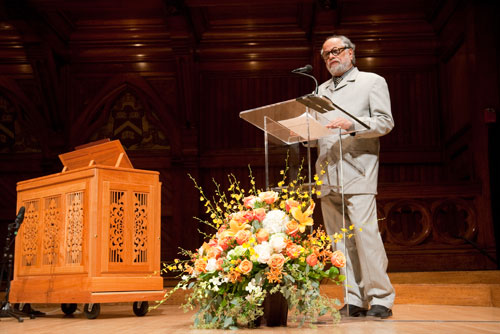
“Ordinary life is one of the most extraordinary aspects of the well-being of society,” said Bhabha, director of the Humanities Center and Anne F. Rothenberg Professor of the Humanities. On 9/11, America lost its claim to the ordinary, as Harvard students and other community members recalled through song, dance, words, and musical performances.
The program concluded with an original performance by Jill Johnson, Harvard’s new director of dance, accompanied by students dispersed across the stage and through the audience. To the strains of “Stabat Mater: XII,” by Italian composer Giovanni Battista Pergolesi, Johnson contorted her body into shapes recalling rebirth and the passage of time: an hourglass, a bird in flight, an outstretched hand. When the dancers finished, there were no final words or applause.
“I think it was extremely moving,” said President Drew Faust, who attended. The humanities, the arts, and the University itself play a role in helping people to process events like 9/11, she added.
“We have much to contribute through learning, through asking questions, through making meaning and understanding,” Faust said. “That’s a lot of what the life of the mind is about, and I think that’s a very important part of these commemorations.”
Share this article
